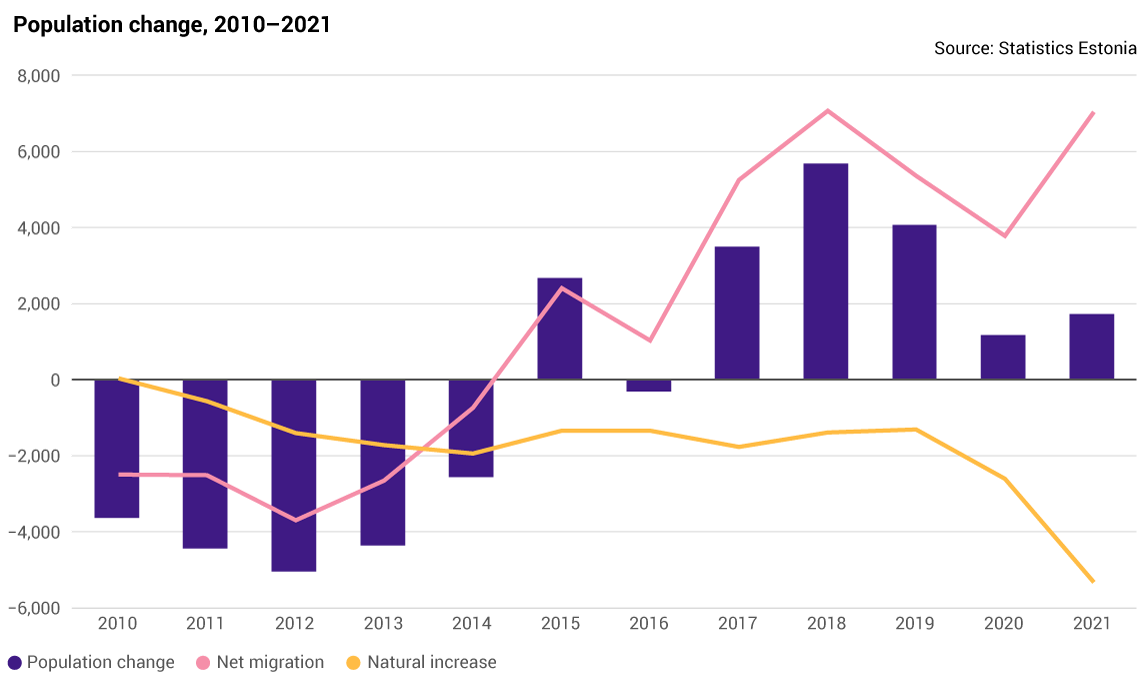Immigration offset the high number of deaths; the population increased
According to Statistics Estonia, on 1 January 2022, the population of Estonia was 1,331,796, which is 1,728 persons more than at the same time a year ago. In 2021, there were 13,272 births and 18,587 deaths in Estonia. Based on migration data, 19,524 persons immigrated to Estonia and 12,481 persons emigrated from Estonia.
Terje Trasberg, leading analyst at Statistics Estonia, said that last year stands out for an exceptionally high number of deaths, as there were 5,315 more deaths than births registered in 2021. “The high number of deaths combined with the number of births, which was similar to the level of recent years, meant that natural increase was negative. On the other hand, net migration was again positive –7,043 more persons moved to Estonia than left for abroad. All in all, Estonia's population increased by 1,728 persons or, figuratively speaking, by the number of people living in the borough of Kiili."
Number of births similar to recent years, number of deaths increased significantly
13,272 children were born last year, which is similar to the number of births in 2020 but 800 fewer than in 2019, when 14,099 children were born. “Comparing the last two years with the pre-coronavirus years, the number of first, second, and third births has decreased, but the number of fourth and more births has increased. There has been a rise in the number of women who gave birth to their first or second child at age 30–44,” explained Trasberg.
There were 18,587 deaths 2021. In the last ten years, the number of deaths has ranged between 15,000 and 16,000, and the difference from year to year has been around 300. “The number of deaths registered last year was extraordinary – the last time mortality was this high was in 1997,” added Trasberg.
In 2021, population of Estonia decreased by 5,315 persons due to natural increase. Tartu county was the only county with positive natural increase. “In general, natural increase is negative throughout Estonia, including the big cities. The only exceptions are rural municipalities around cities, for instance Rae and Saue rural municipalities near Tallinn as well as Luunja and Kambja rural municipalities around Tartu,” said the analyst.
Net migration was positive and immigration was the highest recorded in recent years
In 2021, 19,524 persons immigrated to Estonia and 12,481 persons emigrated from Estonia – arrivals outnumbered departures by a third and net migration remained positive for the seventh year in a row. Most of the migrants were Estonia’s own citizens, whose net migration was positive again after a one-year break. The majority of the immigrants arrive from Finland and Ukraine and most of the emigrants depart for Finland.
Census data will be published on the 1st of June
From June 1, Statistics Estonia will begin publishing the results of the 2021 population census. The census data are used to determine, among other things, how the average age of women at first childbirth has changed over the past 20 years, what percentage of the population identify as Estonian in terms of ethnicity, which languages are spoken as mother tongue in Estonia, and how the percentage of people not born in Estonia has changed over the past two decades.
More detailed data have been published in the statistical database.
See also the population section on our website.
For further information:
Hanna-Liisa Ruul
Communications Partner
Marketing and Dissemination Department
Statistics Estonia
Tel +372 625 9264
